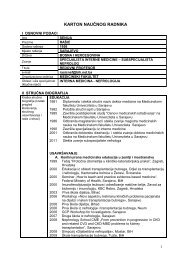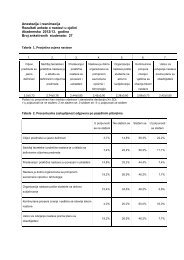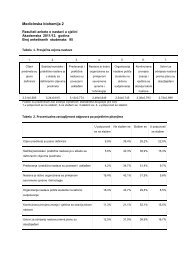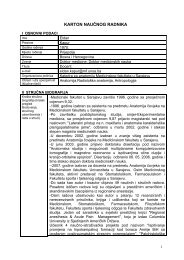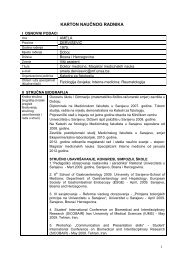Folia Medica 2011; 46 No 1:9-12accommodate all <strong>of</strong> its contents, resultingin protrusion <strong>of</strong> the intestines into the residualextra embryonic coela at the base <strong>of</strong>the umbilical cord. This temporary herniationis called physiologic midgut herniation.Reduction <strong>of</strong> this hernia occurs by the 12 thpostmenstrual week; beyond the 12 th week amidgut herniation is no longer physiological(3). A simple midline omphalocele developsif the extra-embryonic gut fails to return tothe abdominal cavity and remains coveredby the two-layer amniotic-peritoneal layerinto which the umbilicus inserts (1,2,4). Incontrast to fetal bowel, the liver does nothave a physiological migration outside <strong>of</strong>the abdominal cavity during development.Therefore, the liver is never present in physiologicmidgut herniation. However, if thelateral folds fail to close, a large abdominalwall defect is created through which theabdominal cavity contents, including theliver, can be herniated (1,2). The result is aliver-containing omphalocele. The omphalocelemay be small, with only a portion<strong>of</strong> the intestine protruding outside the abdominalcavity, or large, with most <strong>of</strong> theabdominal organs (including intestine, liver,and spleen) present outside the abdominalcavity. A translucent membrane covers theprotruding organs. A “small” type omphalocele(involving protrusion <strong>of</strong> a small portion<strong>of</strong> the intestine only) occurs in one out <strong>of</strong>every 5.000 live births. A “large” type omphalocele(involving protrusion <strong>of</strong> the intestines,liver, and other organs) occurs inone out <strong>of</strong> every 10.000 live births. Isolatedomphalocele occurs in approximately 1 in5000 live births (5). Many babies born withan omphalocele also have other abnormalities.Associated malformation ranges from30 to 88% (6). Babies with omphalocele haveabnormalities <strong>of</strong> other organs or body parts,most commonly the central nervous system,digestive system, heart, urinary system, andlimbs. More boys than girls are affected withomphalocele. The aim <strong>of</strong> this study was toobtain the frequency and sex distribution <strong>of</strong>the omphalocele among cases hospitalizedat the Clinic for Children’s Surgery; ClinicalCenter, <strong>University</strong> <strong>of</strong> <strong>Sarajevo</strong>, Bosnia andHerzegovina, during the period from January2000 to December 2009.Patients and methodsRetrospective study was carried out on thebasis <strong>of</strong> the clinical records in the Clinic forChildren’s Surgery; Clinical Center, <strong>University</strong><strong>of</strong> <strong>Sarajevo</strong>, Bosnia and Herzegovina.From 1 st January 2000 to 31 st December2009, a total <strong>of</strong> 7529 patients were hospitalizedand out <strong>of</strong> that number nine cases(0.119%) were diagnosed as some type <strong>of</strong>omphalocele malformation. Standard methods<strong>of</strong> descriptive statistics were performedfor the data analysis.ResultsA total <strong>of</strong> 9 cases were treated in the Clinicfor Children’s Surgery; Clinical Center, <strong>University</strong><strong>of</strong> <strong>Sarajevo</strong> in the period from 2000to 2009. The number <strong>of</strong> omphalocele casesdoes not vary much in the observed period(Table 1).Table 1. Frequency <strong>of</strong> omphalocele in theobserved periodYear N°2000 02001 12002 12003 22004 02005 12006 02007 02008 22009 2∑ = 910
Selma Aličelebić et al.: Frequency and sex distribution <strong>of</strong> omphalocele in surgically treated infants...At the Clinic for Children’s Surgery;Clinical Center, <strong>University</strong> <strong>of</strong> <strong>Sarajevo</strong> surgicallywere treated cases <strong>of</strong> omphalocelefrom the whole Federation <strong>of</strong> Bosnia andHerzegovina and their geographical distributionis shown in Table 2.Table 2. Frequency <strong>of</strong> omphalocele in theobserved geographical regionCanton N°<strong>Sarajevo</strong> 3Una-Sana 2Zenica-Doboj 2Central Bosnia 1Herzegovina-Neretva 1∑ = 9The structure <strong>of</strong> patients with omphaloceletreated according to the gender is shownin Table 3. Out <strong>of</strong> that num ber 6 (66.66%)were male patients, while 3 (33.33%) werefemale; sex ratio 2:1.Table 3. Total number and gender <strong>of</strong> treatedomphaloceleGENDER N° %MALE 6 66.66 %FEMALE 3 33.33%TOTAL 9 100%Among surgically treated patients wereeight cases <strong>of</strong> “small” type and one case <strong>of</strong>“large” type omphalocele.Isolated omphalocele occurs in four cases,multiple malformations were found infive cases, three cases were with one and twocases were with two associated malformations(Figure 1). Chromosome aberrationswere present in three patients, one patienthad gastrointestinal and one had musculoskeletalmalformation.DiscussionIn the period from 1 st January 2000 to 31 stDecember 2009 a total <strong>of</strong> 7529 patientswere hospitalized. Out <strong>of</strong> that number 9were omphalocele cases (0.119%) and out<strong>of</strong> that num ber 6 (66.66%) were male patients,while 3 (33.33%) were female; sexratio 2:1. Small omphalocele was presentin 8 (88.88%) <strong>of</strong> 9 surgically treated cases,while the large omphalocele was present inonly one patient (11.11%). Anomalies associatedwith omphalocele were present in55.55% patients and the most common werechromosome aberrations (33.33%). Ourdata was consistent with the other studiesthat have shown similar results. It was reportedthat the prevalence <strong>of</strong> omphalocelewas 1:3400 in the period 1994-2002 and1:2709 from 2000 to 2002 in the UnitedStates, sex ratio was 1.7: 1 and 76 % patientsFigure 1 – Frequency <strong>of</strong> omphalocele with associated anomalies11




